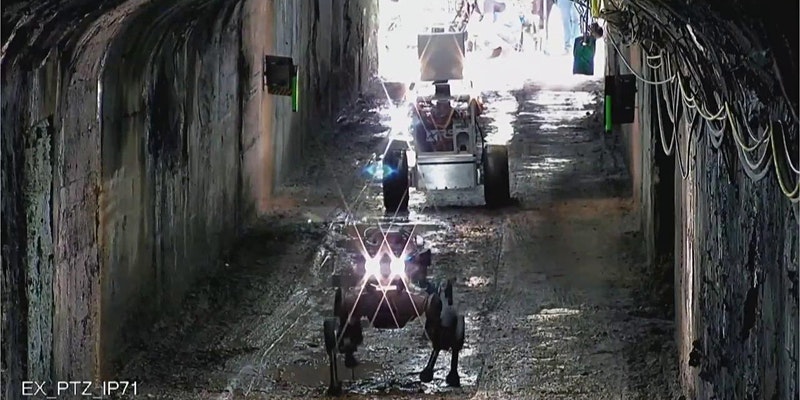The DARPA Subterranean (SubT) Challenge aims to develop innovative technologies that would augment operations underground. On July 20, Dr Timothy Chung, the DARPA SubTChallenge Program Manager, joined Silicon Valley Robotics to discuss the upcoming Cave Circuit and Subterranean Challenge Finals, and the opportunities that still exist for individual and team entries in both Virtual and Systems Challenges, as per the video below.
The SubT Challenge allows teams to demonstrate new approaches for robotic systems to rapidly map, navigate, and search complex underground environments, including human-made tunnel systems, urban underground, and natural cave networks.
The SubT Challenge is organized into two Competitions (Systems and Virtual), each with two tracks (DARPA-funded and self-funded).
SYSTEMS COMPETITION RESULTS
Teams in the Systems Competition completed four total runs, two 60-minute runs on each of two courses, Experimental and Safety Research. The courses varied in difficulty and included 20 artifacts each. Teams earned points by correctly identifying artifacts within a five-meter accuracy. The final score was a total of each team’s best score from each of the courses. In instances of a points tie, team rank was determined by (1) earliest time the last artifact was successfully reported, averaged across the team’s best runs on each course; (2) earliest time the first artifact was successfully reported, averaged across the team’s best runs on each course; and (3) lowest average time across all valid artifact reports, averaged across the team’s best runs on each course.
The Tunnel Circuit final scores were as follows
| 25 | Explorer, DARPA-funded |
| 11 | CoSTAR (Collaborative SubTerranean Autonomous Resilient Robots), DARPA-funded |
| 10 | CTU-CRAS, self-funded winner of the $200,000 Tunnel Circuit prize |
| 9 | MARBLE (Multi-agent Autonomy with Radar-Based Localization for Exploration), DARPA-funded |
| 7 | CSIRO Data61, DARPA-funded |
| 5 | CERBERUS (CollaborativE walking & flying RoBots for autonomous ExploRation in Underground Settings), DARPA-funded |
| 2 | NCTU (National Chiao Tung University), self-funded |
| 2 | Robotika, self-funded |
| 1 | CRETISE (Collaborative Robot Exploration and Teaming In Subterranean Environments), DARPA-funded |
| 1 | PLUTO (Pennsylvania Laboratory for Underground Tunnel Operations), DARPA-funded |
| 0 | Coordinated Robotics, self-funded |
The Urban Circuit final scores were as follows:
| 16 | CoSTAR (Collaborative SubTerranean Autonomous Resilient Robots), DARPA-funded |
| 11 | Explorer, DARPA-funded |
| 10 | CTU-CRAS-NORLAB (Czech Technical University in Prague – Center for Robotics and Autonomous Systems – Northern Robotics Laboratory), self-funded winner of $500,000 first place prize |
| 9 | CSIRO Data61, DARPA-funded |
| 7 | CERBERUS (CollaborativE walking & flying RoBots for autonomous ExploRation in Underground Settings), DARPA-funded |
| 4 | Coordinated Robotics, self-funded winner of the $250,000 second place prize |
| 4 | MARBLE (Multi-agent Autonomy with Radar-Based Localization for Exploration), DARPA-funded |
| 2 | NCTU (National Chiao Tung University), self-funded |
| 2 | Robotika, self-funded |
| 1 | NUS SEDS, (National University of Singapore Students for Exploration and Development of Space), self-funded |
VIRTUAL COMPETITION RESULTS
The Virtual competitors developed advanced software for their respective teams of virtual aerial and wheeled robots to explore tunnel environments, with the goal of finding various artifacts hidden throughout the virtual environment and reporting their locations and types to within a five-meter radius during each 60-minute simulation run. A correct report is worth one point and competitors win by accruing the most points across multiple, diverse simulated environments.
The Tunnel Circuit final scores were as follows:
| 50 | Coordinated Robotics, self-funded |
| 21 | BARCS, DARPA-funded |
| 14 | SODIUM-24 Robotics, self-funded |
| 9 | Robotika, self-funded |
| 7 | COLLEMBOLA, DARPA-funded |
| 1 | Flying Fitches, self-funded |
| 0 | AAUNO, self-funded |
| 0 | CYNET.ai, self-funded |
The Urban Circuit final scores were as follows:
| 150 | BARCS (Bayesian Adaptive Robot Control System), DARPA-funded |
| 115 | Coordinated Robotics, self-funded winner of the $250,000 first place prize |
| 21 | Robotika, self-funded winner of the $150,000 second place prize |
| 17 | COLLEMBOLA (Communication Optimized, Low Latency Exploration, Map-Building and Object Localization Autonomy), DARPA-funded |
| 7 | Flying Fitches, self-funded winner of the $100,000 third place prize |
| 7 | SODIUM-24 Robotics, self-funded |
| 2 | CYNET.ai, self-funded |
| 0 | AAUNO, self-funded |
2020 Cave Circuit and Finals
The Cave Circuit, the final of three Circuit events, is planned for later this year. Final Event, planned for summer of 2021, will put both Systems and Virtual teams to the test with courses that incorporate diverse elements from all three environments. Teams will compete for up to $2 million in the Systems Final Event and up to $1.5 million in the Virtual Final Event, with additional prizes.
Learn more about the opportunities to participate either virtual or systems Team: https://www.subtchallenge.com/

Dr. Timothy Chung joined DARPA’s Tactical Technology Office as a program manager in February 2016. He serves as the Program Manager for the OFFensive Swarm-Enabled Tactics Program and the DARPA Subterranean (SubT) Challenge.
Prior to joining DARPA, Dr. Chung served as an Assistant Professor at the Naval Postgraduate School and Director of the Advanced Robotic Systems Engineering Laboratory (ARSENL). His academic interests included modeling, analysis, and systems engineering of operational settings involving unmanned systems, combining collaborative autonomy development efforts with an extensive live-fly field experimentation program for swarm and counter-swarm unmanned system tactics and associated technologies.
Dr. Chung holds a Bachelor of Science in Mechanical and Aerospace Engineering from Cornell University. He also earned Master of Science and Doctor of Philosophy degrees in Mechanical Engineering from the California Institute of Technology.
Learn more about DARPA here: www.darpa.mil

